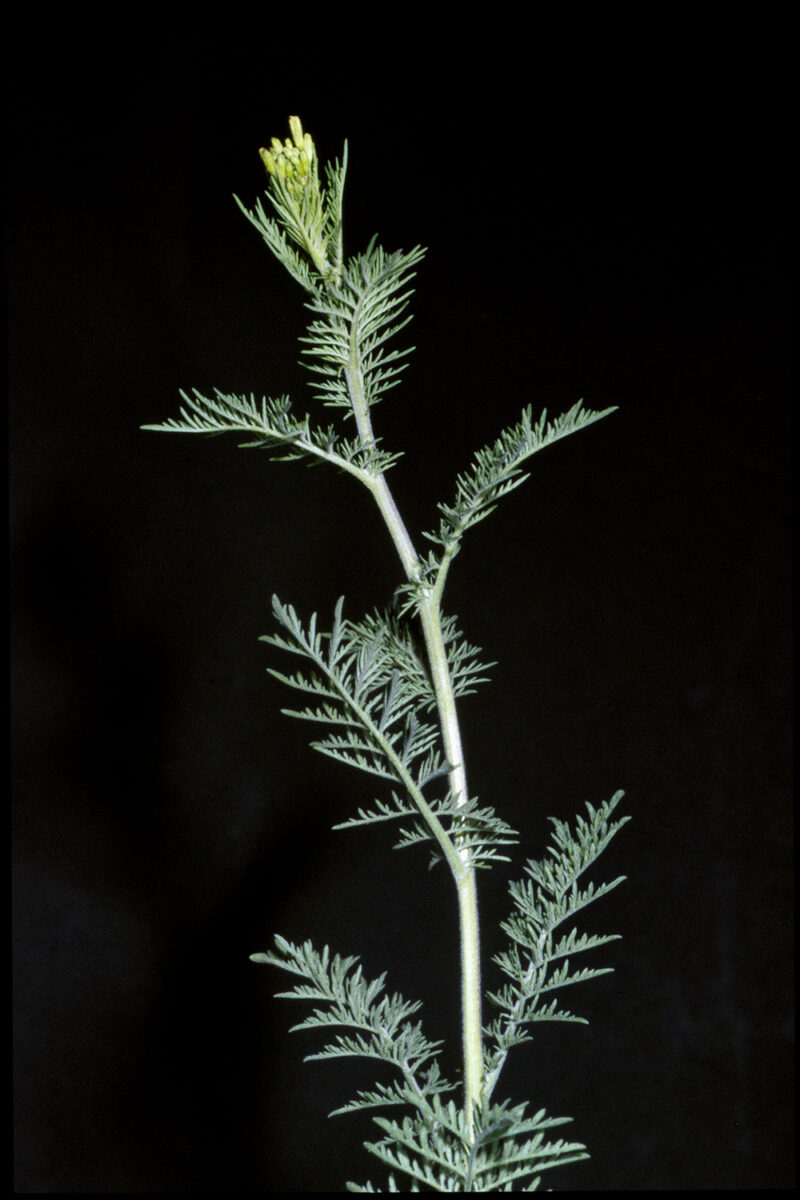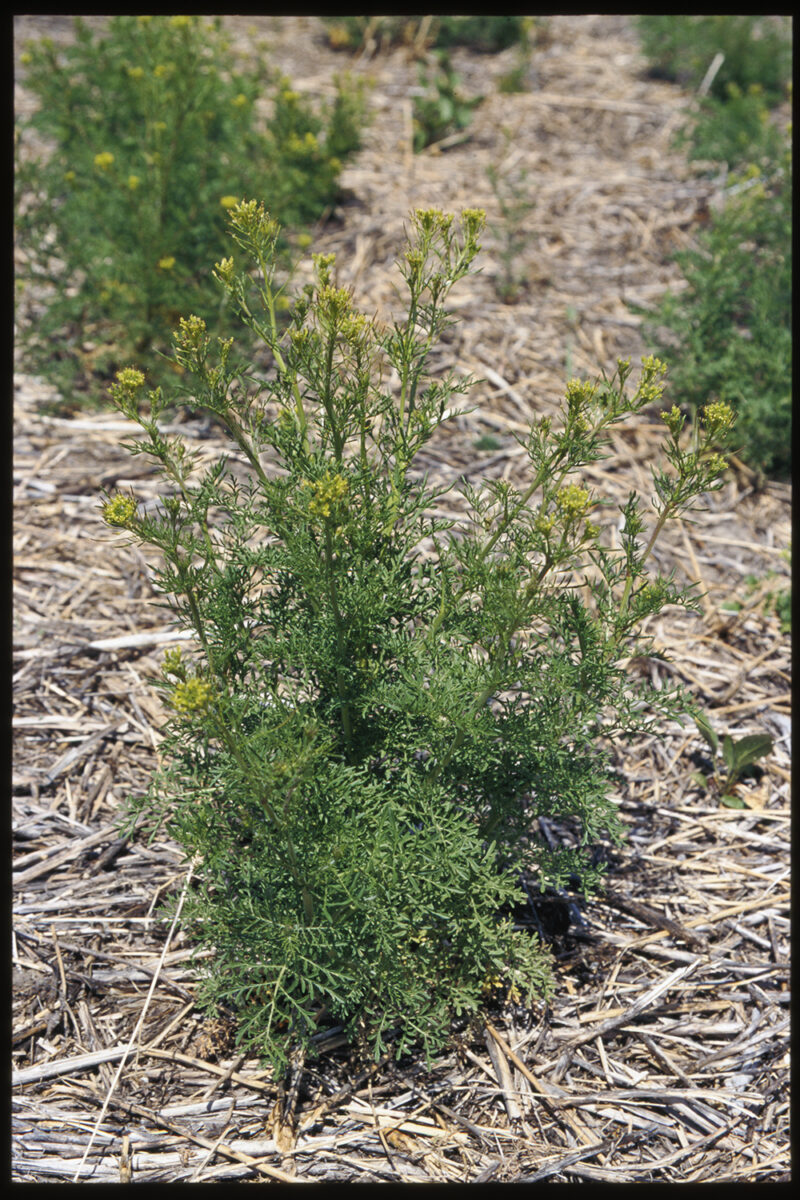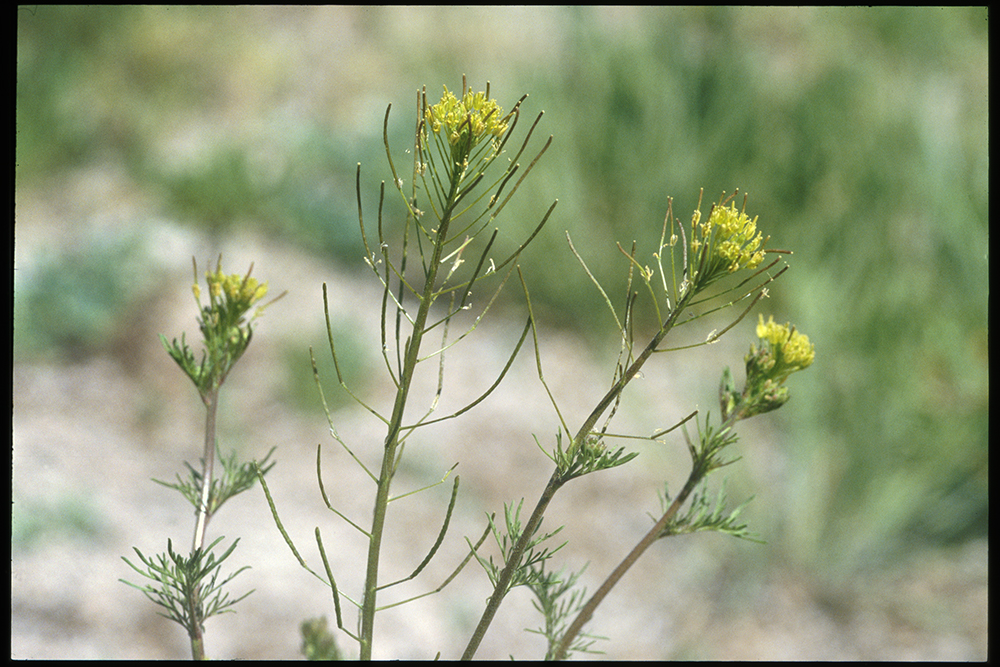Other common names: herb sophia, tansy mustard



Descurainia sophia (L.) Webb ex Prantl
Identification of Flixweed
Family: Mustard family, Brassicaceae
Habit: Slender, erect, branching winter annual or biennial herb
Description: Seedlings have light green cotyledons that are 0.2–0.3 inch long by 0.04–0.06 inch wide, oval to club shaped, and rough due to surface hairs. The seedling stem is short and sparsely hairy. The first true leaves are opposite on the stem, usually tri-lobed, stalked and hairy. All subsequent leaves are alternate and subdivided into leaflets. Leaflets have many narrow, closely spaced lobes. Seedling leaves are 0.13–0.3 inch long and develop into a basal rosette that withers during flowering. Stem and leaves have star shaped hairs. The mature plant bolts from the rosette; stem height ranges from 8–32 inches. The upper half of the hairy stem has branches up to 15 inches long. Stem leaves are 0.75–4 inches long by 0.5–2 inches wide, narrowly oval, pinnate, covered in star-shaped hairs, and narrower when located higher on the stem. Leaflets are narrow and oval to linear in shape with pointy tipped lobes. The taproot is large and sometimes branches. Flowers are green-yellow to yellow, 0.13 inch wide, upward facing, individually stalked, four-petaled and clustered into a triangular group at the stem tip. Flower stalks are 0.5 inch long and are attached perpendicular to the stem. The stem continuously lengthens as new flowers develop at the tip and as seeds ripen lower on the stem. Fruit are long, skinny pods divided into two chambers by a papery, translucent, internal membrane. Pods are green, bluntly round tipped, 0.5–1.25 inch long by 0.04 inch wide, straight or slightly curved; they turn brown at maturity. Seeds are thumb to egg shaped, smooth, dull orange and 0.02–0.05 inch long by 0.01–0.02 inch wide. Each chamber has a row of 10–20 seeds. Seeds are sticky when wet.
Similar species: Pinnate tansymustard [Descurainia pinnata (Walter) Britton] has less finely divided, lacy looking leaves and shorter fruit at maturity; its seeds are in two rows per pod chamber, and the seedling stem is maroon. Smallflowered bittercress (Cardamine parviflora L.) seedlings have similar rosettes, but their leaves are not subdivided into smaller leaf units with central branches.
Management of Flixweed
If feasible, rotate with summer planted crops to reduce flixweed populations. In grain-fallow rotations, good control of flixweed in the fallow years is essential. First tillage with a flat bladed implement should occur before flowers drop. Otherwise, disk lightly to chop up the plants, but, in any case, do not let filled pods form. Following grain-grain rotations, harrow or disk the field shallowly several times between harvest and winter, and then again in the spring. Plow and plant two weeks later. Tine weed the grain before emergence and again as soon as the crop will tolerate it. If further flushes of the weed occur, continue tine weeding until grain stalks begin to elongate. Consider overseeding with a clover at the last tine weeding. This will not compete with the crop but will compete with newly emerging flixweed in the fall and allow the soil to rest from excessive tillage. Flixweed pods often do not shatter until grain harvest so consider trapping chaff to prevent seed return. Alternatively, capture the flixweed seed with the grain in the combine and separate the two later with a grain cleaner.
Although flixweed tolerates crop competition better than most annual weeds, a vigorous crop is still an essential component of management. Ensure that planting density is sufficient to compensate for stand losses that may result from aggressive tine weeding. Except during drought years, the crop is likely to respond to good soil fertility more than flixweed.
Ecology of Flixweed
Origin and distribution: Flixweed is native to Europe and occurs from North Africa to Scandinavia and across Asia to northern India and China. In North America, it occurs throughout the United States, except in parts of the Southeast, and northward in Canada and Alaska to the Arctic. It has also been introduced into South America and New Zealand.
Seed weight: 0.12 mg.
Dormancy and germination: Nearly all flixweed seeds are dormant when shed from the parent plant. Germination is limited in the first fall and spring after seed shed but becomes more plentiful in subsequent falls and springs. Dormancy is broken by exposure to summer-like soil temperatures, with optimum day/night temperatures of 77/59°F. However, seeds will not germinate at this temperature but will wait for cooler temperatures of 59/43°F to 68/50°F. This ensures that the main peak in germination occurs during cool weather in the fall, but after the seeds have experienced summer heat. Light is a primary requirement for germination; few seeds will germinate in dark regardless of temperature. Although some research has shown that a few days of cold (39°F), wet and darkness can break dormancy, other research shows that extended periods of such conditions for longer than five days can induce secondary dormancy to such an extent that spring germination is limited. This ensures that the seeds will not germinate during extended periods of cold in winter or early spring. Seeds germinate best with alternating day/night temperatures. Nitrate breaks dormancy.
Seed longevity: Flixweed forms a persistent seed bank that declines slowly, even with tillage. Nearly all seeds remained viable after 30.5 months burial in Sweden. Viable seeds in undisturbed soil in Alaska declined by 25% per year. Based on the number of seeds surviving after six years in a spring grain-fallow rotation in Saskatchewan, the rate of decline in tilled soil was 23% in clay, 33% in loam and 32% in sandy loam.
Season of emergence: Flixweed emerges primarily in autumn and early spring, with higher emergence in fall than in spring.
Emergence depth: As would be expected for a species with small seeds, flixweed seeds must be near the soil surface for seedling emergence.
Photosynthetic pathway: C3
Sensitivity to frost: Flixweed will survive well at -13°F. It commonly overwinters as a rosette of small leaves; snow cover protects it from cold temperatures and drying winds in far northern latitudes.
Drought tolerance: Flixweed requires moist soil, and it inefficiently uses soil moisture. It is probably abundant in dry regions because of its ability to grow during cool, moist periods of the year.
Mycorrhiza: Flixweed is not mycorrhizal.
Response to fertility: Flixweed shoot growth is relatively unresponsive to N, particularly when growing with a competitive crop. However, roots increase greatly with increasing N fertility, which may increase its competitiveness for water in high N soils. It is relatively unresponsive to P. The extensive taproot system of flixweed facilitates the extraction of nutrients from deep layers of the soil.
Soil physical requirements: The species grows on a wide range of soils from clay to sand, but it is considered an indicator of sandy or stony soils. It tolerates a wide range of pH and can thrive on calcareous sites that are low in humus.
Response to shade: Flixweed can grow in semi-shade. It responds to shade by reduced allocation to roots and greater allocation to leaf area, which is typical of shade-tolerant plants.
Sensitivity to disturbance: Close mowing reduces seed production.
Time from emergence to reproduction: Overwintering seedlings flower about four weeks after resuming growth in spring. Plants emerging in late April in Saskatchewan flowered about one month later, but plants that were not exposed to cold temperatures required several months to reach maturity. Seeds matured in mid-summer, approximately six weeks after the beginning of flowering.
Pollination: Flixweed normally self-pollinates.
Reproduction: Average seed production has been estimated to range from 4,000–76,000 seeds per plant, but an exceptionally large plant produced 700,000 seeds. In a competitive wheat crop, seed production was reduced to 150–250 seeds per plant.
Dispersal: The seeds produce a sticky substance that attaches them to bird feathers. Most seeds die in the rumen, but some can pass through and are spread in manure. Seeds are also spread as contaminants of grain and forage seed. The seeds survive in water for several years and disperse in irrigation water.
Common natural enemies: Flea beetles, cabbage seedpod weevils and beet leaf hoppers use flixweed as an alternative host, but they have little adverse effect on this species.
Palatability: The seeds have a high oil and protein content. Native Americans parched seeds and cooked them into a porridge, made them into bread or used them to thicken soup. Young plants can be eaten raw but have a strong odor and bitter taste. Bitter taste and odor can be removed by boiling for three to four minutes with two changes of water. Flixweed is low in palatability for most livestock, but it sometimes forms an important part of the diet of cattle in the Intermountain West. Consumption of mature plants by cattle can cause poisoning.
Summary Table of Flixweed Characteristics
| Flixweed | ||||||||
|---|---|---|---|---|---|---|---|---|
| Growth habit | Seed weight (mg) | Seed dormancy at shedding | Factors breaking dormancy | Optimum temperature for germination (F) | Seed mortality in untilled soil (%/year) | Seed mortality in tilled soil (%/year) | Typical emergence season | Optimum emergence depth (inches) |
| medium, branched | 0.12 | Yes | wst, li, at, ni | 59/43 to 68/50 | 25 | 23–33 | fall, some early spring | na |
| Photosynthesis type | Frost tolerance | Drought tolerance | Mycorrhiza | Response to nutrients | Emergence to flowering (weeks) | Flowering to viable seed (weeks) | Pollination | Typical & high seed production (seeds per plant) |
| C3 | high | low | no | low | 4–6 | 6 | self | 2,000 & 76,000 |
Table Key
General: The designation “–” signifies that data is not available or the category is not applicable.
Growth habit: A two-word description; the first word indicates relative height (tall, medium, short, prostrate) and second word indicates degree of branching (erect, branching, vining).
Seed weight: Range of reported values in units of “mg per seed.”
Seed dormancy at shedding: “Yes” if most seeds are dormant when shed, “Variable” if dormancy is highly variable, “No” if most seeds are not dormant.
Factors breaking dormancy: The principle factors that are reported to break dormancy and facilitate germination. The order of listing does not imply order of importance. Abbreviations are:
scd = seed coat deterioration
cms = a period subjected to cold, moist soil conditions
wst = warm soil temperatures
li = light
at = alternating day-night temperatures
ni = nitrates
Optimum temperature range for germination: Temperature (Fahrenheit) range that provides for optimum germination of non-dormant seeds. Germination at lower percentages can occur outside of this range. The dash refers to temperature range, and the slash refers to alternating day/night temperature amplitudes.
Seed mortality in untilled soil: Range of mortality estimates (percentage of seed mortality in one year) for buried seeds in untilled soil. Values were chosen where possible for seeds placed at depths below the emergence depth for the species and left undisturbed until assessment. Mortality primarily represents seed deterioration in soil.
Seed mortality in tilled soil: Range of mortality estimates (percentage of seed mortality in one year) for seeds in tilled soil. Values were chosen for seeds placed within the tillage depth and subjected to at least annual tillage events. Seed losses are the result of dormancy-breaking cues induced by tillage, germination and deterioration of un-germinated seeds.
Typical emergence season: Time of year when most emergence occurs in the typical regions of occurrence for each weed. Some emergence may occur outside of this range.
Optimum emergence depth: Soil depths (in inches below the soil surface) from which most seedlings emerge. Lower rates of emergence usually will occur at depths just above or just below this range.
Photosynthesis type: Codes “C3” or “C4” refer to the metabolic pathway for fixing carbon dioxide during photosynthesis. Generally, C3 plants function better in cooler seasons or environments and C4 plants function better in warmer seasons or environments.
Frost tolerance: Relative tolerance of plants to freezing temperatures (high, moderate, low).
Drought tolerance: Relative tolerance of plants to drought (high, moderate, low).
Mycorrhiza: Presence of mycorrhizal fungi. “Yes” if present; “no” if documented not to be present, “unclear” if there are reports of both presence and absence; “variable” if the weed can function either with or without, depending on the soil environment.
Response to nutrients: Relative plant growth response to the nutrient content of soil, primarily N, P, K (high, moderate, low).
Emergence to flowering: Length of time (weeks) after emergence for plants to begin flowering given typical emergence in the region of occurrence. For species emerging in fall, “emergence to flowering” means time from resumption of growth in spring to first flowering.
Flowering to viable seed: Length of time (weeks) after flowering for seeds to become viable.
Pollination: “Self” refers to species that exclusively self-pollinate, “cross” refers to species that exclusively cross-pollinate, “self, can cross” refer to species that primarily self-pollinate, but also cross-pollinate at a low rate, and “both” refers to species that both self-pollinate and cross-pollinate at relatively similar rates.
Typical and high seed production potential: The first value is seed production (seeds per plant) under typical conditions with crop and weed competition. The second value, high seed production, refers to conditions of low density without crop competition. Numbers are rounded off to a magnitude that is representative of often highly variable reported values.
Further Reading
Best, K.F. 1977. The biology of Canadian weeds. 22 Descurainia sophia (L.) Webb. Canadian Journal of Plant Science 57: 499–507.
Blackshaw, R.E. 2004. Application method of nitrogen fertilizer affects weed growth and competition with winter wheat. Weed Biology and Management 4: 103–113.
Landau, C.A., B.J. Schutte, A.O. Mesbah and S.V. Angadi. 2017. Flixweed (Descurainia sophia) shade tolerance and possibilities for flixweed management using rapeseed seeding rate. Weed Technology 31: 477–486.
Mitich, L.W. 1996. Flixweed (Descurainia sophia). Weed Technology 10: 974–977.

